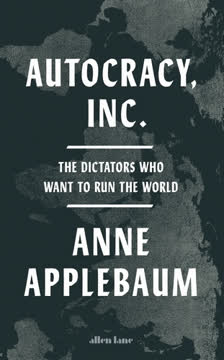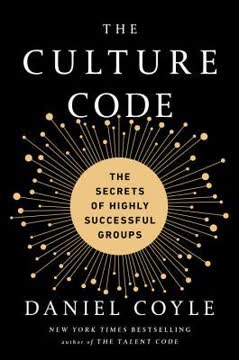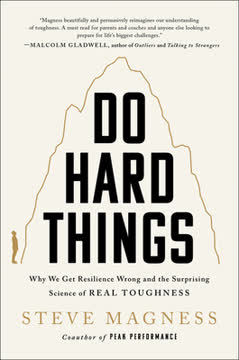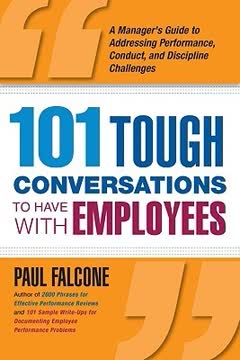Key Takeaways
1. Master the Art of Difficult Conversations
it’s not w hat you say but how you say it that counts.
Focus on delivery. The effectiveness of a tough conversation hinges more on your tone, empathy, and respect than the specific words used. Approaching discussions with compassion encourages a similar response from the employee, even in confrontational situations.
Leverage guilt, not anger. Anger is external and provokes defensiveness; guilt is internal and encourages self-reflection and accountability. Frame issues using "I feel" or "my perception" to invite the employee to take responsibility for their actions or the situation.
Honesty and perception. Be honest about your observations and feelings, using "perception" as a neutral tool ("my perception is..."). This avoids accusations and allows the employee to understand how their behavior is viewed by others, which is crucial for growth and avoiding future issues.
2. Address Personal & Cultural Sensitivities with Tact
Respect, dignity, and cooperation are the cornerstones for handling even the most uncomfortable workplace scenarios.
Handle privately and respectfully. Issues like appearance, hygiene, or cultural practices require private, sensitive discussions. Frame the conversation around the impact on the workplace, coworkers, or clients, rather than personal judgment.
Focus on business impact. Link the personal issue to legitimate business concerns, such as client perception, coworker comfort, or productivity. For example, inappropriate dress or strong food odors can disrupt the work environment.
Seek collaboration and support. Involve the employee in finding solutions or compromises. For complex issues, especially those potentially related to medical conditions (ADA) or protected characteristics (religion, national origin), involve HR or legal counsel to ensure a legally sound and sensitive approach.
3. Tackle Performance Shortcomings Directly
Your job isn't to retool the employee with basic life skills; your role will be to point the individual in the right direction as far as acquiring the appropriate skills, while insisting that work productivity continues at an expected level.
Address specific behaviors. When performance lags (quality, quantity, skills), provide concrete examples of the shortcomings. Avoid vague criticisms and focus on observable actions or lack thereof.
Seek employee self-diagnosis. Ask the employee for their perspective on the problem and what they believe is causing it. This encourages accountability and often reveals underlying issues or misunderstandings.
Set clear expectations and offer support. Define what successful performance looks like and outline specific steps for improvement. Offer resources like training, coaching, or tools, but place the responsibility for improvement squarely on the employee.
4. Enforce Policies Consistently and Clearly
If you’re inconsistent in the application of your organization’s rules, a judge or arbitrator may determine that your fickle actions could justify a claim of wrongful termination, discrimination, or retaliation from a terminated worker.
Communicate rules proactively. Inform employees about company policies and procedures (safety, attendance, internet use, etc.) upfront, explaining the rationale behind them (e.g., safety risks, legal liability, productivity).
Apply policies consistently. Inconsistency in enforcing rules can create legal risk and damage morale. While context matters (e.g., occasional vs. habitual tardiness), the standard for addressing violations should be applied fairly across the board.
Document and outline consequences. For repeated or significant violations, document the issue in writing (e.g., written warning). Clearly state the policy violated, the specific incident(s), the expected improvement, and the consequences of future violations, which often follow a progressive discipline path.
5. Confront Offensive Behavior Decisively
Any incident where a worker is abused, threatened, intimidated, teased, or ridiculed could be grouped under the category of intrusive and harassing behaviors, and such emotional and psychological violence should be taken very seriously in your organization.
Take complaints seriously. Address any report or observation of offensive behavior (harassment, discrimination, bullying, aggressive conduct) immediately. Failure to act can expose the company to significant liability.
Investigate thoroughly. Involve HR, and potentially legal counsel or security, to investigate the allegations objectively. Gather facts and hear all sides before making a determination.
Address behavior firmly. If misconduct is confirmed, address the offending employee directly and unequivocally. Emphasize the impact of their behavior on coworkers and the work environment, and clearly outline severe consequences, which may include accelerated progressive discipline or immediate termination depending on the severity.
6. Cultivate Effective Workplace Communication
Communication is a two-way street: It’s not just about giving information, but it’s also about receiving and digesting new information that propels the next step in the business process.
Coach on core skills. Address deficiencies in listening, upward communication, and information sharing. Use specific examples to illustrate the impact of poor communication on workflow and team effectiveness.
Address negative communication styles. Confront behaviors like whining, complaining, gossiping, or snitching by explaining how they damage morale and trust. Frame the discussion around the employee's perception and its negative impact on the team and their own career.
Manage information flow carefully. Be cautious about confidential requests from employees who report to others. Understand the risks of being placed on notice of potential issues without the ability to act, and involve HR or senior management appropriately.
7. Coach Managers on Leadership Style
If you’re playing this management game correctly, then your life should get easier over time: You’ll work less hard, make more money, and develop satisfaction in seeing others thrive while assuming new responsibilities that you can now delegate.
Provide candid feedback. Address challenging managerial styles (e.g., avoiding confrontation, being overly critical, lacking creativity, being risk-averse) using specific examples and focusing on the perception created and the impact on the team.
Link style to business results. Explain how a manager's style affects team morale, productivity, retention, and ultimately, the department's contribution to the company's goals. Highlight the benefits of adopting more effective leadership approaches.
Encourage self-assessment and development. Ask managers to reflect on their own style, perhaps comparing themselves to past role models. Offer support through training, coaching, or mentorship, but emphasize that changing detrimental behaviors is their responsibility for their own career growth.
8. Implement Progressive Discipline Thoughtfully
As such, the progressive discipline process ensures that your company acts reasonably and consistently and documents the effects of the worker’s unwillingness or inability to do the job adequately.
Follow a structured process. Use a series of escalating steps (verbal counseling, written warning, final written warning) to address performance or conduct issues. This provides the employee with notice and opportunity to improve.
Ensure due process. Before issuing formal written documentation, whenever possible, meet with the employee to hear their side of the story. Incorporate their perspective into the written warning to demonstrate a fair and thorough investigation.
Utilize decision-making leaves. For persistent issues that haven't responded to verbal coaching but don't yet warrant a written warning, consider a paid day of contemplation. This encourages the employee to reflect
[ERROR: Incomplete response]
Last updated:
FAQ
What’s 101 Tough Conversations to Have with Employees by Paul Falcone about?
- Comprehensive manager’s guide: The book provides practical scripts and strategies for managers to address 101 common and challenging employee issues, including performance, conduct, and discipline.
- Focus on verbal interventions: It emphasizes handling problems through respectful, effective conversations before escalating to formal discipline or termination.
- Legal and practical insights: Each scenario includes sample language and notes on legal or HR considerations, helping managers navigate sensitive topics confidently.
- Real-world scenarios: Covers a wide range of workplace situations, from absenteeism to harassment, making it a hands-on resource for supervisors at all levels.
Why should I read 101 Tough Conversations to Have with Employees by Paul Falcone?
- Prevent escalation: The book helps managers address issues early, reducing the likelihood of formal discipline, terminations, or legal disputes.
- Protect legal interests: It teaches how to conduct conversations that create a defensible record and ensure workplace due process.
- Enhance leadership skills: Managers learn to handle tough situations with empathy and firmness, improving team morale and retention.
- Build positive culture: Following the book’s advice fosters open communication, trust, and respect in the workplace.
What are the key takeaways from 101 Tough Conversations to Have with Employees by Paul Falcone?
- Communication is critical: Effective management requires clear, honest, and timely conversations, as well as active listening and setting expectations.
- Documentation matters: Keeping detailed records of discussions and actions protects both the company and employees.
- Address issues promptly: Delaying tough conversations can worsen problems; managers should act quickly and sensitively.
- Respect and dignity: Even in difficult situations like terminations, treating employees with respect preserves dignity and reduces negative fallout.
What are the main rules of engagement for tough conversations in 101 Tough Conversations to Have with Employees?
- Tone is crucial: “It’s not what you say but how you say it that counts”—use respect and compassion to elicit positive responses.
- Use guilt, not anger: Invoking guilt encourages self-reflection and responsibility, while anger leads to resistance.
- Perception language: Use phrases like “I feel” or “I’ve found” to soften critiques and invite dialogue.
- Honesty and openness: Be transparent and direct, but always with empathy and professionalism.
How does Paul Falcone’s method address performance issues and poor work habits?
- Be specific and timely: Identify concrete examples of poor performance and discuss them privately with the employee.
- Seek employee input: Encourage employees to share their perspective and propose improvement plans.
- Set clear consequences: Outline expectations and the possibility of progressive discipline if there’s no improvement.
- Document discussions: Keep records of conversations to track progress and protect against future disputes.
What advice does 101 Tough Conversations to Have with Employees give for handling inappropriate workplace behavior, including harassment?
- Perception management: Address offensive behavior by explaining its impact on others and the legal risks involved.
- Investigate objectively: Rely on evidence and witness statements, not personal judgments, especially in harassment cases.
- Issue clear warnings: Provide formal written warnings for serious or repeated offenses, specifying consequences.
- Involve HR and legal: Seek professional guidance early in complex or sensitive situations.
How should managers handle mediating disputes and interpersonal conflicts according to Paul Falcone?
- Separate meetings first: Meet with each party individually to hear their side and share perceptions.
- Set ground rules: In group meetings, encourage openness, respect, and direct communication.
- Focus on accountability: End with commitments to improve and clarify consequences for continued conflict.
- Document the process: Keep records of meetings and agreements to ensure follow-through.
What strategies does 101 Tough Conversations to Have with Employees recommend for managing substandard communication skills and gossip?
- Set clear expectations: Emphasize the importance of upward communication and keeping supervisors informed.
- Coach listening skills: Help employees improve by focusing on active listening and avoiding interruptions.
- Address gossip directly: Tackle rumors openly, discourage gossip, and hold employees accountable for morale issues.
- Handle complaints carefully: Be cautious with confidential conversations, especially those involving other supervisors’ teams.
How does Paul Falcone recommend addressing cultural and religious differences in the workplace?
- Balance respect and inclusion: Accommodate reasonable religious practices but avoid pervasive displays or proselytizing.
- Open dialogue: Discuss concerns privately and seek mutually agreeable solutions.
- Zero tolerance for proselytizing: Supervisors must not impose beliefs on subordinates; violations warrant formal warnings.
- Consistent enforcement: Apply policies fairly to maintain a respectful and inclusive environment.
What is Paul Falcone’s approach to handling absenteeism and tardiness in 101 Tough Conversations to Have with Employees?
- Understand company policy: Know whether your organization uses a no-fault or excuse-based attendance system.
- Document patterns: Track incidents and note disruptive patterns, such as absences around weekends.
- Communicate early: Meet with employees before issues escalate, explain policies, and require commitments to improve.
- Set consequences: Clarify the impact on workflow and outline disciplinary steps if attendance doesn’t improve.
How does 101 Tough Conversations to Have with Employees advise managers to handle layoffs, terminations, and summary offenses?
- Communicate with empathy: Deliver difficult news clearly and compassionately, allowing time for questions.
- Provide support: Offer severance, benefits, and outplacement services to help affected employees transition.
- Investigate before action: Even with clear evidence, listen to the employee’s side and document the process.
- Maintain dignity and consistency: Handle terminations privately and apply policies fairly to protect company integrity.
What guidance does Paul Falcone offer for managing employees in crisis or returning from leave?
- Prepare the team: Hold meetings before and after an employee’s return to address concerns and reset expectations.
- Address isolation and mental health: Identify isolated employees early and provide access to Employee Assistance Programs.
- Use investigatory leave: Remove threatening employees promptly while conducting fair investigations.
- Coordinate with professionals: Work closely with HR, legal, and mental health providers to handle sensitive cases appropriately.
Review Summary
101 Tough Conversations to Have with Employees receives mixed reviews. Some find it an invaluable resource for managers, providing guidance on various workplace situations. Others criticize it as outdated, inappropriate, and potentially damaging to employee relationships. Positive reviews praise its comprehensive coverage and usefulness as a reference tool. Negative reviews highlight concerns about the book's tone, unrealistic scenarios, and lack of depth in addressing complex conflicts. Many readers suggest adapting the advice to fit modern workplace cultures and using it as a starting point rather than a strict guide.
Similar Books










Download PDF
Download EPUB
.epub digital book format is ideal for reading ebooks on phones, tablets, and e-readers.





